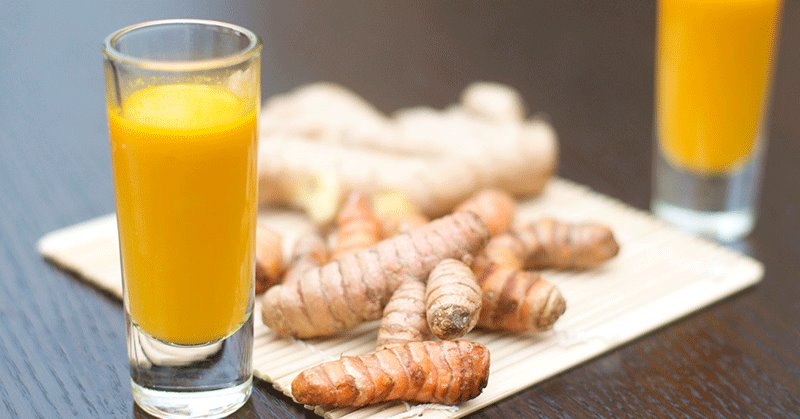CURCUMIN EXHIBITS POTENTIAL IN THE TREATMENT OF VARIOUS CHRONIC DISEASES
The medicinal properties of turmeric (Curcuma longa), the source of curcumin, have been known for thousands of years, but advancements in modern science have provided a scientific basis for using curcumin therapy against numerous human diseases. In this article, the authors discuss the discovery and key biological activities of curcumin, particularly its activities at the molecular and cellular levels, as well as in animals and humans.

The discovery of curcumin dates back 2 centuries ago when Vogel and Pelletier isolated "yellow colouring matter" from the rhizomes of turmeric and named it curcumin (the word curcumin stems from the Persian word "kurkum" [curcuma], which means saffron). Later, the substance was found to be a mixture of resin and turmeric oil.
Although curcumin is effective against many human ailments, it has poor bioavailability, apparently due to its poor absorption, rapid metabolism, and rapid systemic elimination. Efforts have been made to improve its bioavailability by improving these factors. In spite of these limitations in bioavailability, as little as 150 mg curcumin administered twice a day orally in humans was sufficient to lower serum levels of inflammatory biomarkers.
Curcumin is now regarded as a "new drug" with great potential and is being used as a supplement and marketed in several forms, including capsules, tablets, ointments, energy drinks, soaps, and cosmetics.
Curcumin has been shown to modulate various signaling molecules, including inflammatory molecules, transcription factors, enzymes, protein kinases, protein reductases, carrier proteins, cell survival proteins, drug resistance proteins, adhesion molecules, growth factors, receptors, cell cycle regulatory proteins, chemokines, DNA, RNA, and metal ions. Curcumin may cause up- or downregulation, depending on the target and cellular context. These targets fall into 2 categories: those to which curcumin binds directly and those whose activity is modulated indirectly by curcumin; both of these areas are extensively covered in review articles. Among the most important targets of curcumin are the pro-inflammatory transcription factors, which regulate the expression of genes that contribute to tumorigenesis, cell survival, cell proliferation, invasion, and angiogenesis. Another important target is the protein kinases.
Because it modulates multiple signaling molecules, curcumin has been reported to possess pleiotropic activities. In vitro, it has been shown to possess anti-inflammatory, antioxidant, pro-apoptotic, chemopreventive, chemotherapeutic, antiproliferative, wound healing, antinociceptive, antiparasitic, and antimalarial properties.
Curcumin has also been shown to have activity as an antioxidant and free radical scavenger in several in vitro studies. This activity is due to either the hydroxyl group or the methylene group of the α-diketone (heptadiene-dione) moiety. It is also cytotoxic to cancer cells, via the mechanism of apoptosis, and has wide antimicrobial activity.
In animal studies, curcumin has been found to be active against diabetes, obesity, neurological and psychiatric disorders (such as depression, Alzheimer's disease, and Parkinson's disease), and cancer (particularly colon cancer) and cancer-related symptoms such as fatigue, neuropathic pain, and cognitive deficit. It has also shown potential against chronic illnesses affecting the eyes, lungs, liver, kidneys, and gastrointestinal and cardiovascular systems.
About 50 clinical trials have been completed on curcumin's potential in humans. Most have suggested that curcumin is safe and effective to treat a number of diseases, with the most promising effects observed with cancer, inflammatory conditions, skin, eye and neurological disorders, diabetic nephropathy, and pain. Other trials have investigated the role of curcumin in improving body weight and reducing lipid levels in patients with acute coronary syndrome. At the time of this article's preparation, curcumin was undergoing investigation in more than 30 clinical trials, say the authors, adding, "We expect that the completion of these clinical trials will provide further credence to the already established positive effects of curcumin."
Source:cms.herbalgram.org
Liquid Nano Curcumin OIC is available in large pharmacies in Vietnam. Please contact our Customer Service Hotline at 1900636913 or access DISTRIBUTION CHANNELS to receive information of the nearest pharmacy.
The product is not a medicine and cannot replace medicines
The most-read articles
- HEALTHCARE AND THE USE OF NANOTECHNOLOGY IN MEDICAL APPLICATIONS
- HOME REMEDIES FOR A STOMACH ULCER
- GALLBLADDER DISEASE
- TRY TURMERIC FOR QUICK RELIEF FROM A SORE THROAT
- Pycnogenol
- THE BEST THINGS TO KNOW ABOUT THE ALOE VERA PLANT
- RESULTS OF SCIENTIFIC RESEARCH ON LIQUID NANO CURCUMIN OIC
- NANOTECHNOLOGY IN COSMETICS
- OESOPHAGEAL CANCER
- Health Benefits of Mint Leaves
Send your question



